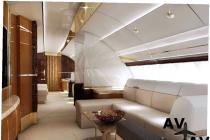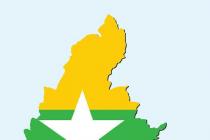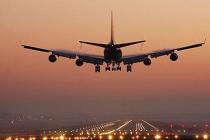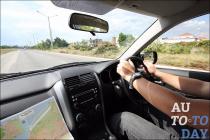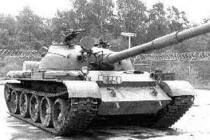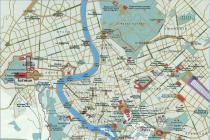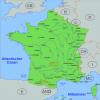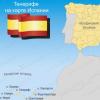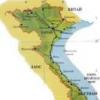(Based on materials from the reference book by I. V. Garmashova "South Africa: Travel and Communicate without Problems" (Moscow, 2000)).
Greetings and handshakes in South Africa
There is a difference in greeting rules between white and black South Africans. If in white culture it is customary for the younger to be the first to greet the elder, then in the culture of blacks the situation is the opposite: the younger must wait until the older greets him.
Just like the Russians, South Africans shake hands when they meet. Moreover, the distance between acquaintances differs from the distance adopted by Russians. Between whites it is more, between blacks it is less than among Russians. White South Africans prefer a strong handshake, while Africans prefer a weak one.
A handshake with black South Africans (the so-called "South African handshake") has distinctive features:
1) shake your interlocutor's hand in a traditional European manner;
2) without taking your hand off the interlocutor's hand, turn your palm with your fingers up and squeeze his palm, clasping his thumb with your index and thumb;
3) return your palm to its original position and again shake the other person's hand in the traditional European manner.
Thus, your handshake will turn out to be three-phase, as is customary in communication among black South Africans.
Communication etiquette
Unlike Russians, South Africans of English descent and black South Africans find it indecent to look at the interlocutor when speaking. This is perceived as aggressiveness. To avoid this reaction, from time to time look at your conversation partner's earlobe.
At the same time, Afrikaners, on the contrary, prefer constant eye contact. If the interlocutor often looks away, Afrikaners consider this a manifestation of insincerity or dishonesty.
When dealing with blacks and Muslims (Indians or Colored people), never give them your left hand. If you want to give them something, do it with your right hand. The left hand in African and Muslim culture is considered dirty.
A black South African will likely prefer to offer you a gift with both hands. This is a sign of special respect. In addition, it is customary for black to accept what is given to them with both hands. This is how they show gratitude.
Black South Africans, if they are friendly, can hold hands while walking, even if they are of the same sex. This is considered only a manifestation of friendly feelings, and not love affection.
In conversations with unfamiliar South Africans, it is better not to touch upon the sore point for them about the political situation in the country or about apartheid. South Africans are still highly divided in their political affiliations. Not all blacks vote for the ruling African National Congress (Mandela's party), and not all whites recall the apartheid era with nostalgia.
At the same time, Afrikaners are generally more conservative than Anglophone South Africans - especially on racial issues. The same applies to their relationships in the family. Younger people often refer to elders using the words “aunt” (Tannie) and “uncle” (Oom). Such an appeal is used not only to relatives, but also to strangers who are older than the speaker.
In an informal setting, talk about work as little as possible. The favorite topic of communication among South Africans is sports. But remember that until the mid-90s, football was considered a predominantly black sport, so many white South Africans are much better at rugby, cricket and golf. At the same time, on the eve of the 2010 FIFA World Cup in South Africa, whites are increasingly interested in this sport.
South Africans usually do not allow long pauses in conversation. Such pauses make them uncomfortable, because they indicate a lack of interest in the conversation. At the same time, excessive assertiveness should be avoided, especially when conducting business negotiations with South Africans.
Black South Africans, even when dealing with strangers, love to inquire about health and family. This is considered an expression of openness and friendliness.
In public places, white and black South Africans have different attitudes towards voice strength and conversation volume. While it is not customary for whites to speak loudly, blacks follow different traditions. According to their ideas, to speak quietly means to gossip, to talk about another person is bad.
Gestures
Some of the gestures typical of South Africans are unknown to Russians. So, for example, waving in front of the face with crossed palms turned inward means "complete lack of understanding", "stupid as a cork."
Another typical South African, but not familiar to Russians, gesture in the meaning of "got in a mess, went nuts" is a slightly raised hand with a palm down, which moves from side to side.
Away
In South Africa, it is customary to agree in advance on the date and time of a visit, often several days in advance. If you have an urgent need to see friends, call and explain the reason for the urgent visit. Do not be offended if the meeting does not take place on the same day. It is likely that your friends have already allocated their free time and cannot disrupt their plans.
Not only for business meetings, but also for guests, you need to come exactly on time: a 10-15 minute delay can ruin your relationship with your South African acquaintances. Punctuality is the golden rule that almost all white South Africans obey. Late for meetings and breaking the agreement among whites in South Africa is usually associated with black behavior. There is even such a concept: "African time".
On weekends, white South Africans, and especially Afrikaners, have a braai, that is, lunch or dinner with meat cooked over a fire. Braai is an analogue of Russian "kebabs". Cooking meat for braai is the prerogative of men. Women prepare salads and snacks. Guests usually bring beer, wine, soft drinks, salads or dessert. If you are invited to a braai, be sure to ask the hosts what to bring.
First, guests talk to the hosts outside, next to the brazier, while watching the meat being cooked. After about an hour, when the food is ready, everyone sits down at the table. Braai often takes place next to the swimming pool, an indispensable attribute of most South African homes, and continues until late at night.
It is better to come to visit with a small gift. It is best to give flowers, a box of expensive chocolate, a cake, a bottle of good wine or a beautiful souvenir from Russia (khokhloma, nesting dolls, scarves, gzhel, vodka, caviar).
Many South Africans, influenced by British traditions, prefer to wash themselves in stagnant water. In addition, water in South Africa is more expensive than in Russia. This means that many homes do not have faucets and that hot and cold water taps are separate. South Africans plug the sink, collect water and then wash in that water. At the same time, the sinks are kept perfectly clean. In homes where there are no faucets, it is customary to wash your hands and wipe the sink dry with a cloth that usually lies nearby, on the edge of the sink or bathtub.
Many Russians are struck by the lack of books in the homes of some South Africans. But, perhaps, you were not shown all the rooms of the house, and the study in which the books are located was left out of your field of vision. You can also recall that some Russians used to collect books, but not always read them.
At breakfast, Afrikaners tend to limit themselves to very little, for example, coffee with croutons. Their lunch is like our breakfast. Soups are not prepared or served during the day, but the dinner is hearty, usually consisting of salads, a main course and dessert, and sometimes soup. The time between lunch and dinner is much longer than in Russia.
Telephone conversations
Don't call your South African friends after 9 p.m. Many South Africans go to bed early because they get up early. Therefore, in South Africa it is considered acceptable to call acquaintances at 7 a.m. or schedule business meetings at 9 a.m.
South Africans usually have only one telephone in their spacious private homes. Therefore, when you call your South African acquaintances, wait a little longer than usual. Perhaps the owner of the house just did not have time to get to the device yet.
In South Africa, it is common for the caller to introduce themselves immediately. Therefore, the first question you will be asked over the phone is "Who" s speaking? ("Who's talking?") Before asking to call someone you want to call, introduce yourself first.
On the street
Since South Africa has left-hand traffic, passers-by walking along the corridors of institutions or sidewalks of the streets will keep left sides and will try to get around you with right sides. Keep this in mind to avoid collisions.
In a taxi, passengers sit in the back seat. It is not accepted to sit next to the driver. But on a trip with your friends in their car, one of the passengers sits next to the driver. Usually his wife sits next to the driver. However, if an older married couple is driving your car, then it is preferable to offer a seat in the front seat to the man, the head of the invited family.
Tip
Tipping is usually given in restaurants and taxis. The tip is about 10% of the bill. Tipping should be given directly to the person who served you. Hotel porters, service personnel at gas stations and parking lots are usually tipped for 3-5 rand.
Working hours of institutions and organizations
Most establishments are open from 8:00 to 17:00, except Saturday and Sunday. Friday is a short day in many institutions and companies. In the period from mid-December to mid-January, many institutions and organizations are closed. Some establishments have a short tea break at 10:00 and 16:00. Banks serve customers from 9:00 to 15:30, on Saturday - from 9:00 to 11:00. Sunday is a day off.
Shops and shopping centers are open, as a rule, from Monday to Friday until 18:00, on Saturday - until 15:00. Shopping malls, some clothing stores (until 13:00) and grocery stores in shopping centers (until 15:00) are open on Sundays.
Shops at petrol stations and car service stations are open around the clock. Spirits are sold only in specialized stores.
Historically, in most countries of the world the rule of right-hand traffic is adopted... But, there are a number of countries in which left-hand traffic. The most ardent representatives are UK, Australia, Japan, Singapore, South Africa and India. There is no exact data on why this happened, but there are many prerequisites that answer this question.
So, it is assumed that the first country in which left-hand traffic was adopted is England, since shipping was developed here and ships moved exclusively left-hand. But first things first. In this article we will try to understand the rules of right-hand and left-hand traffic, describe their advantages and disadvantages, as well as the history of their origin.
1. History of the steering wheel
The history of traffic rules, and as a result, the history of the location of the steering wheel goes back to antiquity. Historians suggest that the Romans faced the first rules. Presumably that in 50 BC Guy Julius Caesar created a number of rules, which had to obey the cabbies, the so-called carriage drivers.
Also, presumably in Rome there was a rule of left-hand traffic. This is evidenced by one of the found Roman denarius, which depicts two horsemen who are scattering on the left side. This is most likely due to the fact that most of the population is right-handed, including the riders and they were forced to hold a weapon in their right hand.
When the times of knights, horsemen and carriages have sunk into the past, the question arose again about the rules of the road, and, accordingly, on which side the steering wheel should be located. At the beginning of the 20th century, the first cars began to fill the streets en masse. At that time, in most European countries, right-hand traffic was adopted, in England, Sweden and partially in Austria-Hungary - left-sided. In Italy, the movement was mixed. All this was not dangerous, since there were not many cars, and their speed was minimal.
In countries with right-hand traffic, it is logical that the steering wheel was located on the right. It was believed that this makes it easier for the driver to overtake. Moreover, the right-hand drive is reflected in the layout of the engine components. In order to shorten the length of the rods, both magneto were located on the right side of the engine. Over the years, cars became more and more, and the question arose about safety during overtaking. The first to produce a left-hand drive car was the world famous Ford corporation. In 1908, the legendary model "T".

After that, the Europeans who produced publicly available cars also switched to "left-hand drive", but manufacturers of high-speed brands kept the "right-hand drive" rule. According to another assumption, it follows that the location of the steering wheel on the left side is convenient because the driver does not go out onto the carriageway, but safely gets onto the sidewalk.
An interesting situation has developed in Sweden. Until 1967, left-hand traffic operated in this country, despite the fact that the steering wheel of cars was on the right side. But on September 3, 1967, all cars stopped overnight and smoothly switched to right-hand traffic. For this, the Swedes in the capital had to suspend traffic for a day in order to change the road signs.
2. The situation in Europe, Asia, Africa, America, Australia
The situation with right-hand and left-hand traffic in different countries of the world evolved in different ways. It is worth considering the most prominent representatives who, over the years, established the rules of the road, based not only on the location of the steering wheel, but also on the physiological characteristics of a person.
 So, after the appearance of cars in Europe, there was complete confusion, which was associated precisely with right-hand and left-hand traffic. Most countries adhered to the right-hand traffic, which has been adopted since the reign of Napoleon. At the same time, countries such as Great Britain, Sweden and partly Austria-Hungary adhered to the left-hand traffic. As mentioned above, in Italy, each city had its own rules. Today, left-hand traffic is present in such European countries as Great Britain, Ireland, Malta, as well as Cyprus (if we consider it as Europe).
So, after the appearance of cars in Europe, there was complete confusion, which was associated precisely with right-hand and left-hand traffic. Most countries adhered to the right-hand traffic, which has been adopted since the reign of Napoleon. At the same time, countries such as Great Britain, Sweden and partly Austria-Hungary adhered to the left-hand traffic. As mentioned above, in Italy, each city had its own rules. Today, left-hand traffic is present in such European countries as Great Britain, Ireland, Malta, as well as Cyprus (if we consider it as Europe).
 In Asia
there are many more countries that adhere to left-hand traffic, in particular, this applies to Japan, India, Sri Lanka, Pakistan, Indonesia, Thailand, Nepal, Malaysia, Singapore, Bangladesh, Macau, Brunei, Bhutan, East Timor and the Maldives.
In Asia
there are many more countries that adhere to left-hand traffic, in particular, this applies to Japan, India, Sri Lanka, Pakistan, Indonesia, Thailand, Nepal, Malaysia, Singapore, Bangladesh, Macau, Brunei, Bhutan, East Timor and the Maldives.
As for Africa, there are also several countries with left-hand traffic, namely: South Africa, Botswana, Uganda, Zambia, Zimbabwe, Kenya, Namibia, Mozambique, Mauritius, as well as Swaziland and Lesotho.
The United States stuck to left-hand traffic until the late 18th century, when there was a smooth transition to right-hand traffic. It is believed that this change was facilitated by a French-born general who fought for the independence of the "states" from the British crown. As for Canada, until the 20s of the 20th century, they adhered to the left-hand traffic. But in such countries of Latin America as Jamaica, Barbados, Guyana, Suriname, as well as Antigua, Barbuda and the Bahamas, they still drive on the left.
Supports the rules of left-hand traffic and Australia, which is the second country in the world in the number of cars per capita. Countries such as New Guinea, New Zealand, Fiji, Samoa, and Nauru and Tonga.
While the UK is considered the main culprit in left-hand traffic, France has largely contributed to right-hand traffic. So, in 1789, during the Great French Revolution, a decree was issued in Paris, which clearly indicated all vehicles to move on the right side, that is, along the common side. Also, a significant role was played by Napoleon, who at one time ordered the army to keep to the right side. All this has had an impact on many countries in Europe.
3. The main differences between right and left-hand traffic
 Right-hand and left-hand traffic implies differences in vehicle designs. As a rule, the driver's seat and steering wheel are located on the left in cars that are designed for right-hand traffic, respectively, in cars for left-hand traffic, the driver's seat and steering wheel are on the right. There are also cars in which the driver's seat is located in the center, for example, the McLaren F1. Also have differences (left and right). But the arrangement of the pedals is in order, the brake, gas was originally inherent in left-hand drive cars, and today it has become the standard for right-hand drive cars.
Right-hand and left-hand traffic implies differences in vehicle designs. As a rule, the driver's seat and steering wheel are located on the left in cars that are designed for right-hand traffic, respectively, in cars for left-hand traffic, the driver's seat and steering wheel are on the right. There are also cars in which the driver's seat is located in the center, for example, the McLaren F1. Also have differences (left and right). But the arrangement of the pedals is in order, the brake, gas was originally inherent in left-hand drive cars, and today it has become the standard for right-hand drive cars.
In general, the main rule of right-hand traffic is to keep to the right, and left-hand traffic to the left. Of course, for right-handers it is initially quite difficult to switch to left-hand traffic, but it is enough to try several times and everything falls into place quickly enough.
4. Disadvantages and advantages of left-hand traffic
 Speaking about the advantages and disadvantages of left-hand traffic, the design of the car cannot be ruled out, since the safety of the driver and his passengers depends on it. Despite the fact that right-hand drive cars are intended for left-hand traffic, they are also operated with right-hand drive. Moreover, it is considered safe because in a collision, the impact falls on the left side and the likelihood of the driver not being harmed is much higher.
Speaking about the advantages and disadvantages of left-hand traffic, the design of the car cannot be ruled out, since the safety of the driver and his passengers depends on it. Despite the fact that right-hand drive cars are intended for left-hand traffic, they are also operated with right-hand drive. Moreover, it is considered safe because in a collision, the impact falls on the left side and the likelihood of the driver not being harmed is much higher.
RHD cars are much less likely to be stolen (in countries with right-hand traffic), as many people find them inconvenient and not functional. Also, the location of the steering wheel on the right side allows the driver to get out of the car not onto the roadway, but onto the sidewalk, which is also much safer.
The driver's unusual gaze from the right side allows you to assess the situation on the road from a different angle, which can lead to a reduction in unforeseen situations. At the same time, there are a number of disadvantages that play an important role not only when driving on the left, but also when driving on the right. So, overtaking on a right-hand drive car is quite inconvenient. The problem can be solved by installing an intelligent mirror system.
In general, the only drawback of left-hand traffic is that it is not widespread. Today, more than 66% of the population adhere to right-hand traffic, and switching to left-hand traffic creates a number of inconveniences. Moreover, only 28% of the world's roads are left-hand... There is also no difference between left-hand traffic and right-hand traffic, just everything happens with a mirror image, which makes drivers who are used to right-hand traffic confused.
 There are also exceptions to the rule. So, in Odessa and St. Petersburg there are streets with left-hand traffic, which are designed to unload the streets from a large number of cars. Also, in Paris on the Avenue General Lemonnier (the only street in Europe), they adhere to the left-hand traffic.
There are also exceptions to the rule. So, in Odessa and St. Petersburg there are streets with left-hand traffic, which are designed to unload the streets from a large number of cars. Also, in Paris on the Avenue General Lemonnier (the only street in Europe), they adhere to the left-hand traffic.
South Africa has a well-developed and well-maintained network of roads and highways, more than 35% of which is paved.
Traffic rules and road signs comply with international standards, but there are a number of significant differences, so before traveling, you should consult with the employees of the rental office about them.
Travel speed in cities is 60 km / h, on highways - 120 km / h, on some roads - 100 km / h. It is compulsory to wear seat belts. As elsewhere, the traffic police strictly enforce the speed limits of drivers.
Last changes: 24.02.2013
Public transport
Urban public transport in South Africa is poorly developed. Buses run rarely, and even less frequently on weekends. Many bus routes are closed on Sunday. Route taxis are for blacks and pose a threat to white passengers.
Every day, many buses make intercity services day or night. Some also travel to Mozambique, Zimbabwe, Namibia and Botswana. Intercity bus transportation is carried out by modern vehicles (air-conditioned) from Greyhound, Intercape Mainliner and Translux. Fares are usually slightly higher than when traveling the same distance by train, but buses are noticeably faster. Tickets are purchased at the ticket offices of bus stations (it is recommended to book tickets for long-distance flights in advance), only on some local routes the driver accepts the payment. On many routes, the passenger can pre-book a trip with intermediate stops at any of the destination points, and without changing the ticket price. There are special fares for long distance travel.
Last changes: 05.06.2010
Taxi
Taxi is difficult to catch on the street (and it is not safe), as in the cities of Europe or America. You need to find a special parking lot, which is very difficult. Taxis are usually called by phone.The cars are quite comfortable and relatively new.
There are two types of taxis - regular taxis with a meter (tariffs are slightly higher, the mileage fee is strictly fixed) and cars of private companies (meters are often absent, the price is negotiated with the driver).
Taxi services are available at all airports and train stations.
Last changes: 05.06.2010
Air transport
International airports are located in Johannesburg, Cape Town and Durban.
The national company South African Airways (SAA) operates many flights connecting all major cities, as well as many capitals of the African continent. Domestic flights are quite expensive, but the service is excellent and the schedule is impeccable.
In recent years, domestic traffic in South Africa has significantly expanded due to the arrival of new airlines, some of which can be classified as "low-cost":
FlyMango flies between Johannesburg, Cape Town, Dubran, Bloemfontaine;
Kulula air flies between Johannesburg, George, Cape Town and Durban. Plus regional international flights to Harare (Zimbabwe), Windhoek (Namibia), Lusaka (Zambia) and Mauritius;
1time Aero flies between Johannesburg, Cape Town, Port Elizabeth, Durban, East London and Zanzibar (Tanzania);
Interlink Airlines (www.interlinkairlines.com), links Johannesburg with Cape Town, Dubran; Kruger Park (Nelspruit), as well as with the neighboring states of Mozambique, Zimbabwe and Tanzania.
Last changes: 05.06.2010
Railway transport
South Africa has an extensive and extensive rail network connecting all major cities. The railway track in the country is narrow.
Intensive commuter train traffic in the Witwatersrand, Pretoria, Durban and Cape Town areas (commuter trains are used only in Cape Town) makes rail connections within the country quite convenient.
The cost of train tickets is relatively low. The luxury trains Blue Train and Rovos Rail, running between Tswane and Cape Town (a separate line connects the capital of South Africa with Zimbabwe), as well as Trans-Karu (Cape Town-Tswane), the Tswane-Dar express train stand apart. es-Salaam and others (the fare in most of them is comparable to a flight by plane). It is recommended to book tickets for all trains, and for deluxe trains - at least 24 hours before departure.
Passenger trains are divided into several classes: Sitter coach (seats), Sleeper-4 (compartment with berths, 4-seater), Sleeper-6 (compartment with berths, 6-seater).
Last changes: 05.06.2010
Car rental
Any driver who is at least 23 years old and has an international driving license can rent a car. The rental price always includes insurance. Upon receipt of the car, the client must pay a deposit for a full tank of gasoline in the amount of 400 ZAR (it is returned when the car is returned with a full tank).If the pick-up and drop-off of the car takes place in different cities or provinces of the country, there is usually an additional fee of ~ 250 ZAR. The car renter is provided with country maps and road atlases free of charge.
Last changes: 05.06.2010
Useful
On internal roads, animals, and often children, often enter the roadway.
Some major highways and highways (marked with the letter "N") are paid, payment is accepted in special machines at the entrance. In some cities, there are street signs located on curb stones.
Be aware that there is a lot of traffic on the highways to Sandton, Illovo and Rosebank in Johannesburg. Peak hours are from 7 to 8:30 and from 16:30 to 18 hours. Large traffic jams during these hours are also formed on the highway between Johannesburg and Pretoria.
Note that road traffic signs are circular with a blue background; hazard warning signs - triangular with a blue background bordered by a red stripe; information boards are mostly green.
The country has a well-developed network of gas stations, most of them work around the clock and have small shops and service stations. There is no self-service at the gas stations. The employee will not only fill the tank with gasoline, but also check the oil, tires and wipe the front glass of your car. There is a tip of several rand for this.
When paying at gas stations, only cash is used and does not accept credit cards, but, as a rule, there are ATMs.
In some cities, there are street signs located on curb stones.
Parking on the street in settlements, as a rule, is paid, carried out with the help of special parking workers (they wear bright colored vests). Paid parking lots are available at large stores. The duration of the car's stay in such a parking lot is indicated in a special coupon. The penalty for parking in an illegal place is quite high.
After getting into the car and closing the door, you must immediately lock it and raise the windows. Especially in the evening, and in unsafe areas. When driving through such areas, the glass in the car is not completely closed, leaving a couple of centimeters on top, but so that you cannot stick your hand outside. An incompletely closed window is more difficult to break. You will be able to buy time and add gas while the attacker swings a second time.
Buy a quick tire repair can. It is not always safe to change a wheel on the road. And the cases when they deliberately throw sharp objects on the road and wait are common. If you catch a bolt in the tire, back off as far as you can and quickly inflate the tire with a can.
Under no circumstances should you drive through black areas such as Soweto, Alexandra and Sebokeng near Johannesburg.
In the big cities of South Africa, black South Africans, teenagers and adults, stand on parking lots and on the side of major streets, waving at you, offering to help you find a parking spot and watch your car. Their services do not guarantee the safety of your vehicle, but it is customary to give them a few rand to tip. The fact is that, with the huge scale of unemployment among the black population, these people could find much less honest ways to earn money. for example, to engage in robbery.
Police phone: 10111, from mobiles - 112. Ambulance - 10177.
1. Don't draw attention to yourself by displaying large amounts of cash and jewelry. A camera around your neck gives you a tourist. Carry it in your shoulder bag.
2. Avoid dark, unlit areas. When returning to your hotel or motel in the evenings, always enter through the front door.
3. Be vigilant, look around before entering the parking lot. Park your car in well-lit places and never give a ride to strangers. Car doors must always be locked. Do not leave things on car seats; put them in the trunk.
4. Plan your trip route in advance, use the map. If you have any doubts about the safety of the area through which you should run, or do not know which road is better to go, contact a police officer. Do not seek help from passers-by on the street. If there is no policeman nearby, go to the nearest store and ask the seller for directions or directions.
5. Close the door of your hotel room and be sure to lock it. Leave your valuables in the safe, which is available in any hotel.
6. Do not show your room keys to anyone, do not leave them on the tables in the restaurant, in the pool or other places where they are easily stolen. Keep an eye on your luggage.
7. Walking alone is dangerous. Always take someone with you if you are going to swim, walk in the mountains or go hiking. In the evenings, try not to ride city buses, minibuses and trains. If you do decide to do this, be sure to take someone with you so as not to be at risk of attack. If you need to go somewhere urgently, take a taxi.
8. If you use ATMs, do not accept help from strangers. Credit card fraud is very common in South Africa.
9. In June-August in South Africa it gets dark at about 5 pm, and in December-February - about 7 pm. In the dark, you should only move around the city by car.
10. When crossing the carriageway, look RIGHT first. and then left. Remember that South Africa is driving on the left.
1. You have to get behind the wheel, always having a mobile phone with you in order to promptly call for help, if necessary.
2. After getting into the car and closing the door, you must immediately lock it and raise the windows. Especially in the evening, and in unsafe areas. When driving through such areas, the glass in the car is not completely closed, leaving a couple of centimeters on top, but so that you cannot stick your hand outside. An incompletely closed window is more difficult to break. You will be able to buy time and add gas while the attacker swings a second time.
3. Buy a quick tire repair can. It is not always safe to change a wheel on the road. And the cases when they deliberately throw sharp objects on the road and wait are common. If you catch a bolt in the tire, back off as far as you can and quickly inflate the tire with a can.
4. Any car alarm can be turned off. But here's the good news: 99% of African thieves are active guys, but a dense, hopeless redneck. Or urban punks with a difficult childhood and wooden toys. They will not cope with even the simplest alarm system. They take it with enthusiasm and quantity. Even a simple flashing light (battery + LED, some icon, for example) somewhere near the dashboard will scare off thieves much better than an expensive alarm. If only you will not forget to turn on the light bulb. A typical African thief does not choose the car he likes, but methodically goes around the entire parking lot until he finds an easier victim. A stick on the steering wheel and something blinking act like a straw scarecrow on a passing crow. I myself used a stick and a light bulb, and the car was stolen from me just like this: when I bought a new one, I put all this “protection” on it, and left the old one in the parking lot under the windows. It was this junk that was stolen, did not have time to sell.
5. Under no circumstances should you drive through black areas such as Soweto, Alexandra and Sebokeng near Johannesburg.
6. At traffic lights in South Africa, it is not allowed to drive through the red. It's just that if you are driving through a dangerous area and pass through an empty intersection without waiting for the green one, the explanation that you feared a robbery will be accepted by the police as a valid reason. South Africa, unlike Europe, lives not only strictly according to the law, but also slightly "according to concepts." But not as frankly as Russia.
7. The most common traffic violations in South Africa:
a) Failure to maintain the distance between cars on the road. b) Drive into the oncoming lane.
c) Drive through a red light.
8. If you want to go here savage, be careful. South Africa is a cool and very beautiful country, there is something to see here. But she has her own unpleasant characteristics. Say, in Sydney or London you can walk around the city at night, but God forbid you do it in Johannesburg (I mean the Central Business District). You shouldn't go there at all, but if you want to see, then, as far as I know, they organize excursions from Sandton (this is the richest and coolest area).
9. Cape Town is a completely safe city, especially by African standards. But this is not some kind of Switzerland, but still Africa. Where all the tourists walk, it is quite possible to walk and even take a taxi and bus. But if in Europe (the south of Italy is not Europe), turning into a quiet alley in the old part of the city, you are likely to stumble upon a beautiful house, chapel or a small garden with a fountain, then in Cape Town it is most likely a trash heap. There are no beauties in the back streets (I walked around - I know), but they can easily stab and clean their pockets there. Not that the probability is 100%, but if even one case in a thousand, is it worth it?
10. You can run into any part of the world, you just have to follow the rules of the game that were not invented by us (in my opinion, these rules are much simpler than in Moscow, at least by their presence): do not meddle in certain areas (the rule is common for almost the whole world ), do not leave valuable junk in the car in plain sight and a few more similar ones. As for the way of life, it is very different from the Moscow one. For example, in South Africa there is no “street” life at all, the “freedom” of children is severely limited, but this has always been the case, and the main reason for this is not the high level of crime, but, in fact, the complete absence of public transport. So there is nothing to be afraid of - you just have to really imagine life here with its traditions, pluses and minuses.
Umlungu (Cape Town-California):
In South Africa, the problem is not so much the quantity as the quality of the crime. In Europe, for example, there will be one armed robbery for every 1000 pickpockets, and vice versa in South Africa. A pickpocket is a profession that requires talent and many years of training. In Africa, the problem of “lack of skills” is not limited to programmers and engineers.
There will not be as many pickpockets in all Cape Town as they work on the same street somewhere in London or Berlin. And the pistol or knife hangs, and go ask for money - for this you only need a desire and a pistol. You don't even need to know English, you can first shoot or stab, and then pick up what God sent. Sometimes they do it.
Those who make it scare with prison is like a hedgehog with a bare bottom. During the grim revelry of apartheid, when blacks were not considered human, there were some unpleasant moments in the prison - a cement floor with no bedding, an elephant skin whip and huge biting dogs. Having lost these components, the modern prison has become in every way more attractive than the free life in the slums. For those who grew up there, the prospect of getting a bullet in the forehead does not mean anything special, an empty phrase.
They use weapons both in attack and in defense immediately, without ceremony. Professional security guards (private agencies are thriving) shoot in the head without warning. To avoid unpleasant analysis of evidence in court. The robbers know this very well and do not count on a warning shot in the air.
Sokol (Johannesburg):
But, at the same time, blacks to whites in South Africa are treated here as children to adults and vice versa. Without going too far on this topic, I can only say from personal experience - bydlyak and rudeness, which are so common in the native Council of Deputies, are absent here at all among all races and nationalities. Moreover, if my white compatriots always treated me like the overwhelming majority of blacks here, I would not have left my native Fatherland in due time.
A state with a well-developed road network. One third of them are covered with high quality asphalt. There are no special features, compared to Europe, in the rules of the road. A mandatory requirement is the use of seat belts and compliance with the speed limit - 6 km / h in the city, 100 km / h on some roads, and up to 140 km / h on highways. To move around the city, there is a network of car rental salons. This is one of the economical options for moving tourists.
Transport in South Africa is very diverse:
- automobile;
- railway;
- water;
- air (including international).
Automobile transport
The total length of motorways in the country is over 200,000 kilometers. This is 10 times more than the length of the railway lines. Left-hand traffic, there are many cars of all known and unknown brands, including luxury ones. Many highways were specially renovated for the 2010 FIFA World Cup.
Gasoline at filling stations is only 95th plus one type of diesel fuel. The choice is limited, but the quality is quite high.
There are a lot of highways. Each has at least 3 stripes on each side. The fare is paid, however, there are almost no traffic jams, which significantly saves time.
There are many road signs. On highways, they are attached to wooden poles, while in the city, only to steel pipes. Dangerous sections of the road are equipped with special illuminated road signs. It turns on when it gets dark. This is usually a pair of orange lamps. If you do not want to pay extra, you can choose free bypass roads (marked on road signs with the letter "T"). The most interesting road sign in South Africa is the prohibition to stand under an umbrella at the table.
There is no tinting on cars. The only exception is police cars. You can move around the country both by rented cars and by taxi. You need to call the car exclusively by phone. It is not accepted to vote on the street. Yes, and it is not at all safe for a white person to travel with an unfamiliar driver.
Among the locals, this type of public transport is popular, such as minibuses and buses. They are well stocked and comfortable to ride. The prices are affordable. For tourists, any type of public transport in South Africa is taboo.
 |
 |
Railway transport
Trains connect all major cities in the country. South African railways are narrow gauge, however, the trains are modern. True, only black people can use such a service. It is dangerous for whites to travel by rail.
In addition to trains, there are electric trains. The cost of the trip is not high, so any local with a job can afford to travel from to and from. Exceptions are luxury trains (Trans-Kuru, Blue-Train). You can take them on a trip only after pre-booking tickets. The fare is high.

All trains can be divided into three types:
- sedentary;
- compartment with 4 seats;
- compartment with 6 places.
Air traffic
There are 3 international airports in South Africa - in Durban, in and in. The cost of flights is high, but the quality is excellent and there are no delays between flights, all planes leave strictly on schedule.
In 2010, low-cost companies entered the air transport market - FlyMango, Interlink Airlines (also flies to Mozambique, Tanzania, Zimbabwe), Kulula Air (except for domestic flights, they deliver passengers to Zimbabwe, Zambia, Namibia and Mauritius.)
Tambo is considered the main airport in South Africa. It is located near Johannesburg and handles over 20 million passengers a year.

Water transport
The main port of South Africa is located in the city. The South African naval forces in the Indian Ocean are also based here. The parameters of the fairway leading to this port are 152 m (width) and 12.8 m (depth). Up to fifty ships can be simultaneously located near the berths.
Also on the territory of South Africa there are three more, no less significant, ports - in Cape Town, Simonstad and Mossel Bay. The latter is the home base of the country's naval forces, as well as the southernmost port. Submarines and aircraft carriers are based in Simonstad.

Transport in South Africa is well developed and diverse. However, tourists are advised to use a taxi to travel around the city where they have come to rest, and by plane to fly from one destination to another. All other forms of transport are unsafe for a white person.

